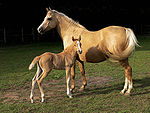- Newfoundland pony
-
Newfoundland Pony 
Newfoundlands in Change IslandsCountry of origin Canada (Newfoundland) Horse (Equus ferus caballus) The Newfoundland pony is a breed of pony originating in Newfoundland formerly used as a beast of burden. It was considered the all purpose pony, in large part because it has several desirable characteristics: stamina, strength, intelligence, courage, obedience, willingness, and common sense. Newfoundland ponies are generally hard workers and easy keepers.
Physical Characteristics
Physical characteristics of the Newfoundland pony include a height of 11-14.2 hands in height; a dark, thick mane, and also a dark, thick tail in lower sections. It is commonly brownish in color though other colors are common; some Newfoundland ponies experience mild to drastic color changes from season to season. The weight of the pony ranges from 400 up to 800 pounds, its hooves are small, hard, and its tail is low set. Newfoundland Ponies can come in a variety of colors that include blue roan, grey, chestnut, black, and bay.
History
The ancestors of the Newfoundland pony arrived in Newfoundland from the British Isles. The ancestors were predominantly Exmoor but also included the Welsh Pony, the Galloway Pony (extinct), and the New Forest pony, which adapted well to the similar climate. Over a few centuries, the early pony immigrants interbred (without human management) and merged into one common type, which is now recognized as the Newfoundland pony.
In the past, the Newfoundland pony was used for ploughing, assisting with gardens, hauling fishing nets, gathering hay, and carrying wood, and they were also used for transportation. With the advent of mechanisation, the Newfoundland Pony's uses were taken over by machines, and the pony population dropped. The population now numbers fewer than four hundred, and they are now considered critically endangered by Rare Breeds Canada.
More than 12,000 Newfoundland ponies were once known to roam Newfoundland, mostly near the coastal communities that were settled by emigrants who arrived from England and Ireland in the 17th and 18th centuries to fish the waters of the North Atlantic. The population declined quickly in the 1960s when the need for a Newfoundland pony to assist with the chores was replaced by supermarkets or mechanized equipment such as ATVs, tractors, and snowmobiles. As a result, the pony lost its value and many were sold under the understanding they were going to new homes but this often meant a ride on the "meat truck". The "meat truck" roamed the Island looking for ponies that could be used for dog food or brought to a horse slaughter and meat processing plant in Quebec.
In 1979, with less than 100 ponies then in existence, the Newfoundland Pony Society was formed. One of its founding members was Dr. Andrew Fraser who was a veterinarian trained in Scotland who had moved to Newfoundland. Dr. Fraser saw the similarities of these ponies to the Moorland ponies from the United Kingdom and set out to protect them from certain extinction. In conjunction with others, Dr. Fraser set out to find and document the last remaining ponies in the Newfoundland Pony Society Registry. Dr. Fraser later wrote a book on the Newfoundland Pony in 1992 called "The Newfoundland Pony - The Lone Member of the Moorland Family of Horses in North America Now on the Verge of Extinction".
Later in 1997, the Government of Newfoundland and Labrador enacted the Heritage Animal Act and the Newfoundland Pony was recognized as the Province's first heritage animal. This resulted in greater protection for the animal and provided the basis to encourage others to help with the efforts to save the Newfoundland Pony.
Today there are relatively few ponies in Newfoundland when compared to the past and many over the years have found homes in most of the other provinces in Canada as well as into the United States.
External links
Equine Equine science and
management
Equestrianism
and sportGlossary of equestrian terms · List of Equestrian Sports · Horse tack · Bit · Bridle · Saddle · Harness · English riding · Western riding · Driving · Horse training · Horse racing · Equestrian at the Summer Olympics (medalists, venues) · Horse show · EquitationEvolution and history Domestication · In warfare · In the Middle Ages · Horses in East Asian warfare · History of the horse in South Asia · Horses in the Napoleonic Wars · Horses in World War I · Horses in World War II · History of the horse in BritainHorse breeds, types
and other EquidaeList of horse breeds · Wild horse · Feral horse · Stock horse · Gaited horse · Draft horse · Warmblood · Sport horse · List of horse breeds in DAD-ISOther EquusHybridsCategory: Equidae Categories:- Horse breeds
- Horse breeds originating in Canada
- History of Newfoundland and Labrador
Wikimedia Foundation. 2010.
